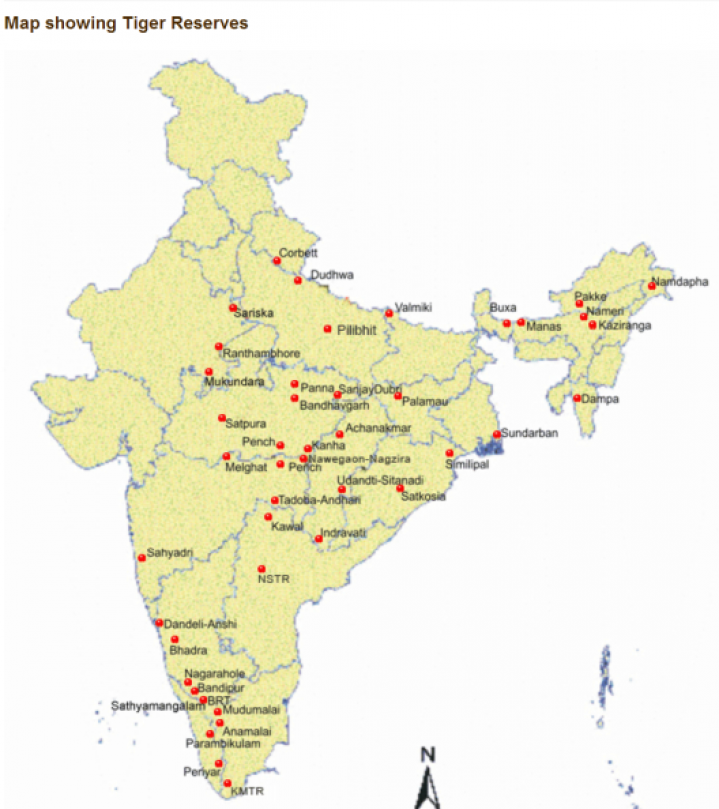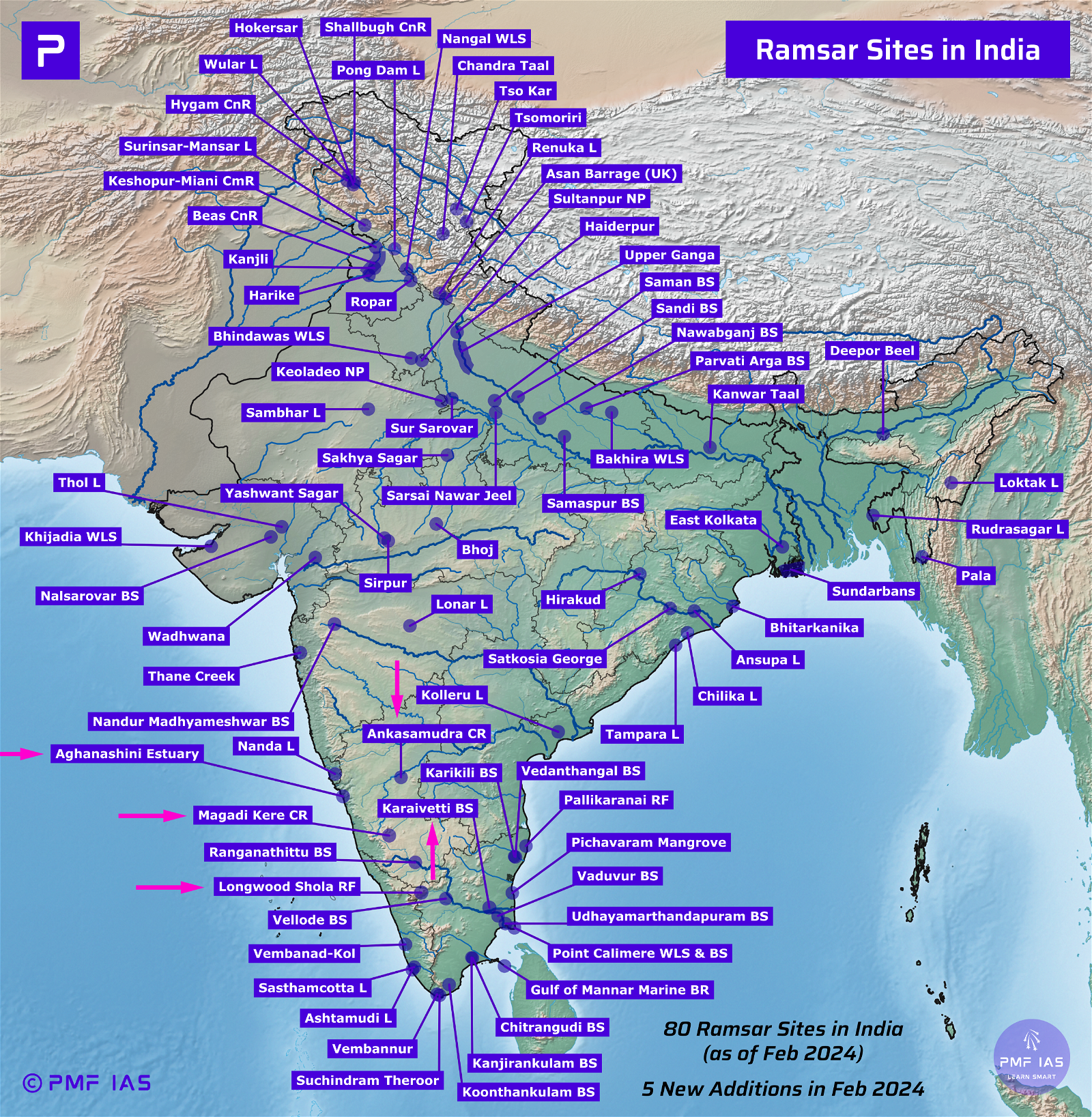
Project Tiger, Elephant, Snow Leopard, Hangul, Rhino Vision 2020
Subscribe to Never Miss an Important Update! Assured Discounts on New Products!
Must Join PMF IAS Telegram Channel & PMF IAS History Telegram Channel
Project Tiger – Tiger Conservation
- Indian tiger population at the end of the 20th century was estimated at 20,000 to 40,000 individuals.
- The first country-wide tiger census conducted in 1972 estimated the population to comprise a little more than 1,800 individuals, an alarming reduction in tiger population.
- In 1973, Project Tiger was launched in the Palamau Tiger Reserve, and various tiger reserves were created in the country based on a ‘core-buffer’ strategy.
- Project Tiger was launched in Jim Corbett National Park of Uttarakhand in 1973.
- India has more than 80 national parks and 441 Sanctuaries of which some have been declared as Tiger reserves.
- Tiger reserves are governed by the Project Tiger (1973).
- It is a Centrally Sponsored Scheme of the Ministry of Environment and Forests.
- It is administered by the National Tiger Conservation Authority.
- Aim: Protect tigers from extinction by ensuring a viable population in their natural habitats.
- Government has set up a Tiger Protection Force under PT to combat poachers.
- PT funds relocation of villagers to minimize human-tiger conflicts.
Core and Buffer zones
- The Tiger Reserves are constituted on a ‘core-buffer strategy’.
Core Zone
- The core area is kept free of biotic disturbances and forestry operations, where collection of minor forest produce, grazing, human disturbances are not allowed within.
- These areas are required to be kept for the purposes of tiger conservation, without affecting the rights of the Scheduled Tribes or such other forest dwellers.
- These areas are notified by the State Government in consultation with an Expert Committee (constituted for that purpose).
Buffer Zone
- The Act defines buffer zone as the area peripheral to the critical tiger habitat or core area providing supplementary habitat for dispersing tigers, besides offering scope for co-existence of human activity (tribals).
- The limits of such areas are determined with the concerned Gram Sabha and an Expert Committee constituted for the purpose.
Problems involved with Project Tiger
- The Forest Rights Act passed by the Indian government in 2006 recognizes the rights of some forest dwelling communities in forest areas. This has led to controversy over implications of such recognition for tiger conservation.
- The project overlooks the role of abuse of power by authorities in the tiger crisis.
Tiger Task Force
- The implementation of Project Tiger over the years has highlighted the need for a statutory authority with legal backing to ensure tiger conservation.
- On the basis of the recommendations of National Board for Wild Life, a Task Force was set up to look into the problems of tiger conservation in the country.
- The recommendations of the Task Force include strengthening of Project Tiger by giving it statutory and administrative powers.
National Board for Wild Life ==> Tiger Task Force ==> National Tiger Conservation Authority
National Tiger Conservation Authority (NTCA)
- The National Tiger Conservation Authority was established in December 2005 following a recommendation of the Tiger Task Force.
- National Tiger Conservation Authority administers Project Tiger.
- Administration of the tiger reserves will be in accordance with guidelines of NTCA.
- Tiger reserves in India are administered by field directors as mandated by NTCA.
- No alteration in the boundaries of a tiger reserve shall be made except on a recommendation of the NTCA and the approval of the National Board for Wild Life.
- No State Government shall de-notify a tiger reserve, except in public interest with the approval of the NTCA and the approval of the National Board for Wild Life.
The Wild Life (Protection) Amendment Act, 2006
- The Act provides for creating
- National Tiger Conservation Authority and
- Tiger and Other Endangered Species Crime Control Bureau (Wildlife Crime Control Bureau).
NTCA members
- The Wildlife Protection Amendment Act, 2006 provides for the constitution of the National Tiger Conservation Authority.
- NTCA was set up under the Chairmanship of the Minister for Environment and Forests.
- The Authority will have
- eight experts having qualifications in wildlife conservation and welfare tribals,
- 3 MPs,
- The Inspector General of Forests, in charge of project Tiger, will be ex-officio Member Secretary
- Others
Functions of NTCA
- The Authority lays down standards, guidelines for tiger conservation in the Tiger Reserves, National Parks and Sanctuaries.
- The Tiger Conservation Authority would be required to prepare an Annual Report, which would be laid in the Parliament along with the Audit Report.
- State level Steering Committees will be set up in the Tiger States under the Chairmanship of respective Chief Ministers.
- This has been done with a view for ensuring coordination, monitoring and protection of tigers in the States.
- A provision has been made for the State Governments to prepare a Tiger Conservation Plan.
- Provision will be made for the States to establish a Tiger Conservation Foundation, based on the good practices emanating from some tiger reserves.
Reasons for falling number of tigers
- Pressure on habitat, Habitat fragmentation and Habitat destruction: Caused due to large-scale development projects such as dams, industry, mines, railway lines etc.
- Incessant poaching: Tigers are killed so their body parts can be used for Traditional Chinese Medicine.
- Invasive species: Destroy the local producers. This has a cascading effect on the food chain. Tigers are the worst hit as they are at the end of the food chain. [Tigers represent an “Umbrella Species” that indicate the health of the ecosystem.]
Steps Taken by the Government for Tiger Conservation
Legal Steps
- Amendment of the Wild Life (Protection) Act, 1972 to Wild Life (Protection) Act, 2006 for providing enabling provisions towards constituting the National Tiger Conservation Authority and the Tiger and Other Endangered Species Crime Control Bureau.
- Enhancement of punishment in cases of offence relating to a tiger reserve or its core area.
Administrative Steps
- Strengthening of ant poaching activities, including special strategy for monsoon patrolling.
- State level Steering Committees under the Chairmanship of Chief Ministers and establishment of Tiger Conservation Foundation.
- Creation of Special Tiger Protection Force (STPF) [Budget 2008]
Financial Steps
- Financial and technical help is provided to the States under various Centrally Sponsored Schemes, viz. Project Tiger and Integrated Development of Wildlife Habitats.
International Cooperation
- India has a bilateral understanding with Nepal on controlling trans-boundary illegal trade in wildlife
- India has signed a protocol on tiger conservation with China.
- India has signed a with Bangladesh for conservation of the Royal Bengal Tiger.
- A sub-group on tiger/leopard conservation has been constituted for cooperation with the Russian Federation.
- A Global Tiger Forum of Tiger Range Countries has been created for addressing international issues related to tiger conservation.
- India is a party to CITES. CITES’s landmark decision states that ‘tigers should not be bred for trade in their parts and derivatives’.

Titbit: There are eight subspecies of tiger: among the eight, at present five subspecies are present in the wild. They are Bengal, South China, Indochinese, Sumatran, and Siberian. Three subspecies of tiger — Caspian, Bali, and Javan — are extinct.
Reasons for slightly increased tiger population recently
- Wireless communication systems and outstation patrol camps have been developed within the tiger reserves, due to which poaching has declined considerably.
- Fire protection is effectively done by suitable preventive and control measures.
- Voluntary Village relocation has been done in many reserves.
- Livestock grazing has been controlled to a great extent in the tiger reserves.
- Various compensatory developmental works have improved the water regime and the ground and field level vegetation.
- Stringent punishments for violators.
- GIS based digitized database development to evaluate tiger population.
Estimation of Tiger Populations
- The process of estimating the number of tigers in a given area is called ‘Tiger census’.
- It is conducted at regular intervals to know the current tiger populations and population trends.
- Besides estimating the number of tigers the method also helps to gather information on the density of the tiger populations and associated prey.
- The most commonly used technique in the past was ‘Pugmark Census Technique’.
- In this method the imprints of the pugmark of the tiger were recorded and used as a basis for identification of individuals.
- Now it is largely used as one of the indices of tiger occurrence and relative abundance.
- Recent methods used to estimate the numbers of tigers are camera trapping and DNA fingerprinting.
- In camera trapping, the photograph of the tiger is taken and individuals are differentiated on the basis of the stripes on the body.
- In the latest technique of DNA fingerprinting, tigers can be identified from their scats.
Project Elephant
- Tiger faces threat of extinction, whereas the elephant faces threat of attrition.
- The elephant numbers have not increased or decreased drastically but there is an increasing pressure on the elephant habitats.
- Project Elephant was launched in 1992.
- It is a centrally sponsored scheme.
Objectives:
- to assist states having populations of wild elephants and to ensure long term survival of identified viable populations of elephants in their natural habitats
- addressing man-animal conflict.
- Developing scientific and planned management measures for conservation of elephants.
- Protecting the elephants from poachers, preventing illegal ivory trade and other unnatural causes of death
Elephant Corridor
- An elephant corridor is defined as a stretch/narrow strips of forested (or otherwise) land that connects larger habitats with elephant populations and forms a conduit for animal movement between the habitats.
- This movement helps enhance species survival and birth rate.
- There are 88 identified elephant corridors in India.
- Out of total 88 corridors, 20 are in south India, 12 in north-western India, 20 in central India, 14 in northern West Bengal and 22 in north-eastern India.
Threats to Elephant Corridors
- Habitat loss leading to fragmentation and destruction caused by developmental activities like construction of buildings, roads, railways, holiday resorts and the fixing solar energized electric fencing, etc.
- Coal mining and iron ore mining is the two “single biggest threats” to elephant corridors in central India.
- Orissa, Jharkhand and Chhattisgarh, are mineral-rich states, but also have the highest number of elephant corridors in the country, which makes them known for elephant-man conflicts.
- There is also a serious poaching problem, as elephant ivory from the tusks is extremely valuable.
- Elephants need extensive grazing grounds and most reserves cannot accommodate them. If protected areas are not large enough, elephants may search for food elsewhere. This often results in conflicts with humans, due to elephants raiding or destroying crops.
Mitigation
- Fusion of the corridors with nearby protected areas wherever feasible; in other cases, declaration as Ecologically Sensitive Areas or conservation reserves to grant protection.
- During the process of securing a corridor, monitoring for animal movement have to be carried out; depending on the need, habitat restoration work shall also be done.
- Securing the corridors involves sensitizing local communities to the option of voluntarily relocation outside the conflict zones to safer areas.
- Preventing further fragmentation of the continuous forest habitat by encroachment from urban areas.
Initiatives for protecting elephants
Monitoring of Illegal Killing of Elephants (MIKE) Programme
- Mandated by COP resolution of CITES, MIKE program started in South Asia in the year 2003 with following purpose:
- To provide information needed for elephant range States to make appropriate management and enforcement decisions, and to build institutional capacity within the range States for the long-term management of their elephant populations
Haathi Mere Saathi
- Haathi Mere Saathi is a campaign launched by the Ministry of environment and forest (MoEF) in partnership with the wildlife trust of India (WTI).
- The campaign was launched at the “Elephant- 8” Ministerial meeting held in Delhi in 2011.
- The E-8 countries comprise of India, Botswana, the Republic of Congo, Indonesia, Kenya, Srilanka, Tanzania, and Thailand.
- This public initiative was aimed at increasing awareness among people and developing friendship, companionship between people and elephants.
Indian (One Horn) Rhino Vision 2020
- One horned rhino are poached for their horns.
- Indian rhino vision 2020 implemented by the department of environment and forests, Assam.
- The programme will be supported by WWF — India, the international rhino foundation (IRF), and a number of local NGOs.
- Translocations are the backbone of the IRV 2020 program.
- The goal set was to populate the potential rhino habitat areas identified viz. Manas NP, Dibru Saikhowa WLS, Laokhowa-Bura Chapori WLS with a viable population of rhino through translocations from Kaziranga NP and Pobitora WLS.
- Manas National Park was selected as the first site for translocation of rhinos.
- Ten rhinos have been released into Manas since 2008. Ten more rhinos will be moved from Kaziranga National Park before the end of the year.
- The vision of this program is to increase the total rhino foundation in Assam from about 2000 to 3000 by the year 2020 and to ensure that these rhinos are distributed over at least 7 protected areas (PA) to provide long term viability of the one-horned rhino population.
- Concentrating so many rhinos in a single protected area like Kaziranga exposes the species to risks of calamities (epidemics, floods, massive poaching attempts).
Project Snow Leopard
- The snow leopard is a globally endangered species.
- Merely 7,500 are estimated to be surviving over two million square kilometres in the Himalaya and Central Asian mountains.
- Most snow leopard occur in China, followed by Mongolia and India.
Threats posed due to
- Human interference,
- competition with livestock – people kill them to save their livestock,
- retreating deeper into mountains due to global warming, and
- poaching.
Why to conserve the high altitude ecosystem?
- The high altitudes of India (> 3000 m) (including the Himalaya and Trans-Himalaya biogeographic zones) support a unique wildlife assemblage of global conservation importance.
- This includes highly endangered populations of species such as the snow leopard, two species of bears, wolf, red panda, mountain ungulates such as the wild yak, chiru, Tibetan gazelle, Tibetan argali, Ladakh urial, two species of musk deer, the hangul, three species of goral, serow, and takin, etc. High altitude lakes and bogs provide breeding grounds for a variety of avifauna including the black-necked crane, barheaded Geese, brahminy ducks, and brown-headed gulls, etc.
- India has ratified international agreements promoting the conservation of high altitude wildlife species such as the snow leopard.
- In 2003, the Convention on Migratory Species included the snow leopard as a Concerted Action Species under its Appendix I.
- Similarly, in 2003, the Convention on International Trade in Endangered Species (CITES) expanded the scope of the CITES Tiger Enforcement Task Force to include all Asian big cat species including the snow leopard.
Sea Turtle Project
- A significant proportion of world’s Olive Ridley Turtle population migrates every winter to Indian coastal waters for nesting mainly at eastern coast.
- With the objective of conservation of olive ridley turtles and other endangered marine turtles, MoEF initiated the Sea Turtle Conservation Project in collaboration of UNDP in 1999 with Wildlife Institute of India, Dehradun as the Implementing Agency.
- The project is being implemented in 10 coastal States of the country with special emphasis in State of Orissa.
- The project has helped in preparation of inventory map of breeding sites of Sea Turtles, identification of nesting and breeding habitats along the shore line, and migratory routes taken by Sea Turtles, development of guidelines to safeguard and minimize turtle mortality.
- One of the important achievements have been demonstration of use of Satellite Telemetry to locate the migratory route of Olive Ridley Turtles in the sea and sensitizing the fishermen and State Government for the use of Turtle Exclusion Device (TED) in fishing trawlers to check turtle mortality in fishing net.
Indian Crocodile Conservation Project
- The Indian Crocodile Conservation Project has pulled back the once threatened crocodilians from the brink of extinction and place them on a good path of recovery.
Objectives
- To protect the remaining population of crocodilians in their natural habitat by creating sanctuaries.
- To rebuild natural population quickly through ‘grow and release’ or ‘rear and release’ technique.
- To promote captive breeding,
Captive breeding means that members of a wild species are captured, then bred and raised in a special facility under the care of wildlife biologists and other expert.
Bringing an animal into captivity may represent the last chance to preserve a species in the wild.
- To take-up research to improve management.
- To build up a level of trained personnel for better continuity of the project through training imparted at project-sites and through the (erstwhile) Central Crocodile Breeding and Management Training Institute, Hyderabad.
- To involve the local people in the project intimately
Project Hangul
- The Kashmir stag also called Hangul is a subspecies of Central Asian Red Deer native to northern India.
- It is the state animal of Jammu & Kashmir
- In Kashmir, it’s found in Dachigam National Park at elevations of 3,035 meters.
- These deer once numbered from about 5,000 animals in the beginning of the 20th century.
- Unfortunately, they were threatened, due to habitat destruction, over-grazing by domestic livestock and poaching.
- This dwindled to as low as 150 animals by 1970. However, the state of Jammu & Kashmir, along with the IUCN and the WWF prepared a project for the protection of these animals.
- It became known as Project Hangul. This brought great results and the population increased to over 340 by 1980.
Ganges Dolphin
- The Ministry of Environment and Forests notified the Ganges River Dolphin as the National Aquatic Animal.
- The River Dolphin inhabits the Ganges-Brahmaputra-Meghna and Karnaphuli-Sangu river systems of Nepal, India, and Bangladesh.
- It is estimated that their total population is around 2,000 and they are listed in Schedule I of the Wildlife Protection Act (1972).
- The Ganges Dolphin is among the four “obligate” freshwater dolphins found in the world — the other three are the ‘baiji found in the Yangtze River (China), the ‘bhulan’ of the Indus (Pakistan) and the ‘boto’ of the Amazon River (Latin America).
- Although there are several species of marine dolphins whose ranges include some freshwater habitats, these four species live only in rivers and lakes.
- The Chinese River Dolphin was declared functionally extinct by a team of international scientists in 2006.
- In India, the Ganges River Dolphin is threatened by river water pollution and siltation, accidental entanglement in fishing nets and poaching for their oil.
- In addition, alterations to the rivers in the form of barrages and dams are separating populations.

















